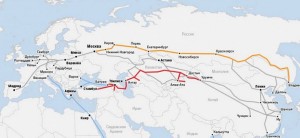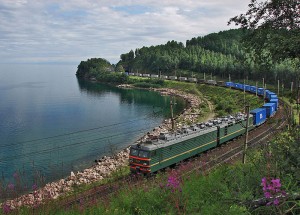
The news about the opening of a new transit railroad, dubbed the “Silk Wind”, connecting China with Europe and bypassing Russia has gone largely unnoticed. The project was launched in 2012 on Kazakhstan’s initiative and was not entirely completed. For instance, the Georgia-Turkey railroad segment was supposed to be completed by the end of 2016. More difficulties are currently arising in connection with the particularities of the numerous customs points in transit countries. Unified customs regulations and rules for transit goods that are being transported via the “Silk Wind”, are still to be implemented.
Today, the Russian Trans-Siberian Railroad is being used to transport goods from China to Europe. Its major advantage compared to sea transportation consists in cutting traveling time more than threefold. China is the major “user” of the Trans-Siberian Railroad, with the share of its goods in the total transit cargo transported via the Russian railroad network amounting to 50 percent. No wonder that China is looking for alternative railroad routes to transport its goods to Europe, and is in fact the main investor in the “Silk Wind” project.
By 2020, when the “Silk Wind” is supposed to reach its projected throughput capacity, it will either equal or exceed that of the Trans-Siberian Railroad.
However, the situation might actually turn out to be even worse for the state rail monopoly Russian Railways (RZD). Built in the early 20th century, the Trans-Siberian Railroad, along with its Soviet addition, the Baikal-Amur Mainline (BAM), should have undergone at least some modernization a long time ago in order to maintain today’s schedule and volume of cargo traffic. In recent years, RZD has been regularly requesting and successfully receiving allocations from the Russian federal budget toward this end–in April 2013, in August 2014, and in November 2014. In 2010-2012, there was already talk about the Trans-Siberian Railroad having exhausted its potential for development, and there were even proposals being voiced for constructing a second BAM.
Russian Audit Chamber considers the sizable sums of money that are being regularly allocated to the railroads from the federal budget as inefficient spending: RZD is number one in the assumed rating of the most inefficient state companies. Forbes Magazine notes that in many of the costly RZD tenders victory was awarded to the sole

participant, while the recently published high-profile investigation by Alexei Navalny’s Anti-Corruption Foundation reported that a company owned by the son of the Prosecutor General, Artyom Chaika, purchased the 75 percent share in a company that produces and supplies crushed stone to RZD, and thus has a guaranteed buyer in the state railroad monopoly. Another son of the Prosecutor General, Igor, has purchased a stake in Russia’s largest producer of railroad sleepers (95 percent in the country).
The problem lies not only in the inefficiency and corruption of the state railroad monopoly, but also in the fact that the “corpulent” years will not return for the Russian economy, which means that there will be no money in the budget for modernizing the Trans-Siberian Railroad. This means that Russia’s railroads, which even two years ago were four times slower than US railroads (themselves not the fastest in the world), will likely lose the competition against the “Silk Wind,” which will attract the majority of the Chinese transit.
As a result, the outdated Trans-Siberian Railroad, which remains the only rail route connecting the European part of Russia with the country’s Far East, could go into such decay that it would be timely to speak not only about the negative economic consequences, but about a risk to Russia’s territorial integrity itself.





